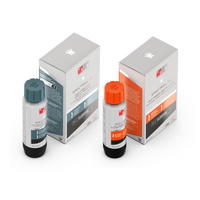Treating a receding hairline
Treatment of your receding hairline depends on the underlying cause. For example, if you have the autoimmune thyroid condition, Hashimoto’s thyroiditis, treatment of your receding hairline will rely on synthetic thyroid hormone medication. For most people, especially men, a receding hairline is due to genetic factors. Although we cannot change our genes, we can try using products and medications to improve hair growth.
A popular treatment option for receding hairline is minoxidil (Rogaine). Available in nearly all drug and grocery stores, minoxidil is one of the oldest topical agents that aims to reverse hair loss. However, Rogaine is not without side effects, and these side effects can go beyond the skin. Furthermore, Rogaine has not demonstrated that it can prevent receding hairline, which is one of the greatest concerns in consumers with hair loss.
Enter nanoxidil, a topical solution that can treat receding hairline with no known side effects. Known by its brand names Spectral.DNC-N® and Revita®, nanoxidil works by:
- Healing the scalp and hair follicles
- Regulating growth factors
- Inhibiting DHT (dihydrotestosterone) development and reversing the effects of DHT
- Supporting keratin production
The above mechanisms of nanoxidil collaborate well to increase hair growth and decrease hair loss without the topical and systemic side effects of Rogaine.
Other possible treatment options for receding hairline include essential oils, corticosteroid injections, topical steroids, surgical hair restoration, and platelet-rich plasma therapy. Some oral medications and supplements may be used to promote hair growth, including biotin and finasteride. Indeed, finasteride is a well-known oral medication that is prescribed by medical doctors to treat hair loss.

















